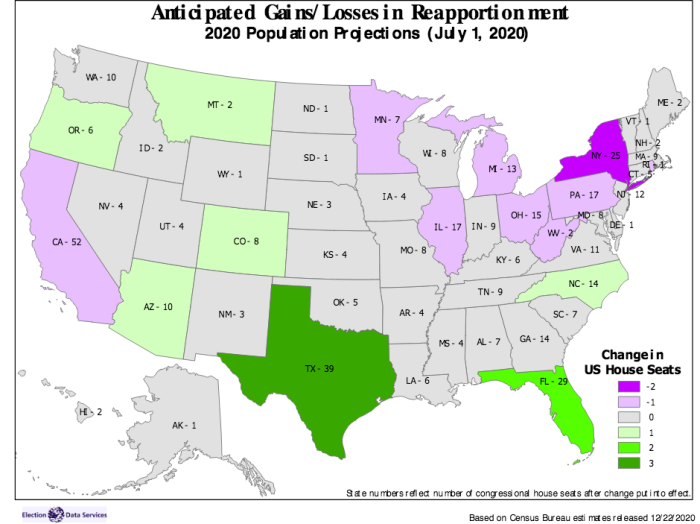The U.S. Census Bureau’s latest state population estimates confirm what has long been likely: Iowa will maintain four Congressional districts at least until 2030.
The Census Bureau previously estimated our state’s population at 3,155,070 as of July 1, 2019. Data published on December 22 indicate that as of July 1, 2020, Iowa had 3,163,561 residents, of whom 2,438,002 (77.1 percent) are at least 18 years old.
Those preliminary numbers do not represent the actual 2020 census count, which will be used for Congressional apportionment after the totals become available in early 2021. That said, the final count won’t be far from the July 2020 estimate.
According to the latest Election Data Services projections, Iowa is not among the states at risk of losing a district (or certain to lose one) following this year’s census. In fact, with roughly 790,000 people living in each of our state’s four U.S. House districts, Iowa would rank either ninth or tenth nationally in terms of states with the most populous Congressional districts following the 2020 census (see the analysis on pages 7 and 10).
If recent trends hold, Iowa would have a chance to maintain four districts following the 2030 census. That would be the first time in a century that the state had the same number of Congressional districts for three decades in a row. Iowa dropped from eleven districts to nine following the 1930 census. Our U.S. House representation shrank to eight districts following the 1940 census, seven following the 1960 census, six following the 1970 census, five following the 1990 census, and four following the 2010 census.
Under the redistricting process in place since 1980, Iowa’s nonpartisan Legislative Services Agency will deliver a set of proposed Congressional and state legislative maps to the Iowa House and Senate by April 1, 2021. However, that date could be pushed back if states receive population data from the U.S. Census Bureau later than usual, due to complications related to the COVID-19 pandemic.
Final note: States that delivered 306 electoral votes to Joe Biden this year will have a total of 301 or 302 electoral college votes in 2024, depending on whether Alabama and New York each lose one district, or whether Alabama holds steady while New York loses two districts. The new Election Data Services analysis explains those scenarios.
Top image: Map created and first published by Election Data Services, based on population estimates released on December 22.

